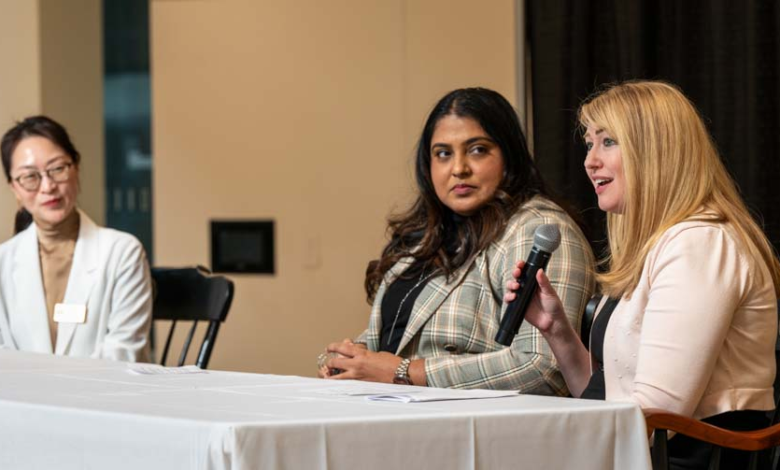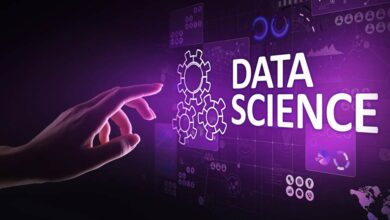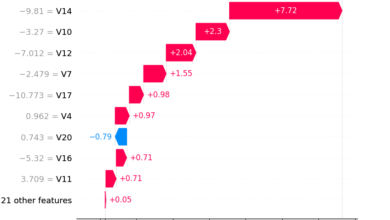Analytics Without Borders explores AI trends, skills needed for landing data-driven jobs

On March 22, students, researchers, academics, and business professionals gathered at Bryant University for the seventh annual Analytics Without Borders conference. Hosted in partnership with Tufts University, Bentley University, and Nichols College, the day-long event featured compelling talks, interactive workshops, and networking opportunities where attendees discovered the latest advancements in analytics and artificial intelligence.
“This event is truly an opportunity for everybody to showcase their work, share insights, and engage in productive discussions that go beyond our organizational boundaries,” said Bryant University President Ross Gittell, Ph.D.
Committed to integrating analytical strategies and solutions into the university’s curriculum, Gittell explained that Bryant launched graduate programs in Data Science, Business Analytics, and Healthcare Informatics last year and will be creating a cutting-edge AI data center in the university’s new Business Entrepreneurship and Leadership Center.
“One of the most important topics of our time is about harnessing the power of analytics and AI to improve society and education. When analytics and AI are done right, it can be a force for positive change for creating solutions that will benefit the next generation of students, industries, and community leaders,” Gittell told attendees.
Following the opening remarks, keynote speaker Todd Gustafson ’86, president of HP Federal LLC and head of U.S. Public Sector at HP Inc., provided tips on the skills needed for a successful data analytics career; suggestions included forming your career map and goals, understanding the cloud, being a good communicator, never compromising your integrity, and being willing to embrace change and speak up. He also highlighted AI’s influence within his industry and noted that HP is already thinking of ways to make its intellect, product design, and software future ready.
“Make sure you understand that life is continuous learning and that you don’t miss that opportunity to go forward, particularly in the AI and data science world,” said Gustafson, who — during his talk — presented Gittell with a mission coin as an appreciation for HP’s partnership with Bryant. “You’re going to run into people who won’t embrace you for critical thinking, and others who will. Find environments where they won’t hinder you and take advantage of that.”
The microphone was then passed to Michael Jabbour, Microsoft’s education chief innovation officer, who explained that AI can create a more equitable educational experience for students and help teachers and administrative offices with certain tasks. Jabbour recently spent under an hour using AI and data analytics to create a flexible elementary schedule for a school district.
“The district reported back that this one 45-minute session saved them 10,000 hours of planning time,” said Jabbour.
.png)
With AI top of mind, attendees also heard from Bryant’s Center for Teaching Excellence (CTE) Director Terri Hasseler, Ph.D., and CTE Associate Director and Teaching Support Constanza Bartholomae, who talked about approaching AI detection systems from a teaching and learning perspective. Hasseler noted that, currently, the accuracy of these systems is low, and detectors only do well if something is 100 percent human-written or AI-written. Through restructuring assignments, teaching students how to effectively use and cite AI, and more, faculty can navigate the world of opportunities that AI offers.
Looking to share their wisdom with the up-and-coming analysts, six individuals — including Bryant alumni — participated in a career discussion panel where they talked about their current roles, the tools they regularly use such as Python, Sequel, and Tableau, and past academic courses they’ve found helpful.
“One piece of advice I can give is to try to understand the industry you’re going into,” said Daniel McGowan, advanced analytics solutions director for Fidelity Investments. “Sometimes data scientists and analysts can be order takers, which you don’t want to do. You want to understand the business so you can be more of a consultant when you work with stakeholders. That’s going to make you more valuable because you can inject your ideas and take the ask to the next level.”
Dustin Cabral ’09, Cleartelligence LLC’s data visualization and analytics practice director, suggested that students create a portfolio. Even if they have limited experience or use cases, there’s free online data they can use to build a portfolio.
.png)
“It might be a visualization portfolio, it might be a coding portfolio, but have something tangible for people to look at and understand what level you’re at and what you can produce,” said Cabral, who also held a beginner’s workshop on Tableau at the conference.
Later in the afternoon, attendees received more career advice from Preethi Lodha, the University of Massachusetts’ data analytics and insights manager, and Katy Sandlin McMahon, Cleartelligence’s practice director for application development, during a “Women in Analytics” panel. Working in a male-dominated field, the two spoke to the adversity they’ve faced, how people can support women in analytics, and the mentors they’ve found along the way.
“Keep your mind open to having multiple mentors or identifying people who you would like to emulate,” Lodha told attendees.
.png)
Throughout the day, students and faculty spoke about recent and ongoing research where they’ve used analytics to advance understanding in healthcare, business, and beyond. Bryant’s Assistant Professor of Information Systems and Analytics ML Tlachac, Ph.D., discussed the pervasiveness of mental health disorders and how passive sensing modalities – such as text messages – can be leveraged for mental health assessments. Staying in the healthcare realm, Associate Professor and Healthcare Informatics Program Director Nafees Qamar, Ph.D., spoke about an eHealth solution that could improve childhood immunization coverage since 10 to 30 percent of children in developing countries do not receive routine vaccines – leading to 700,000 annual deaths.
Moving onto climate change, Professor and Information Systems and Analytics Department Chair Suhong Li, Ph.D., provided attendees with an analysis of how sadness and anger were the most prevalent emotions in social media conversations regarding extreme weather events from the past 10 years. Coming back to AI, Associate Professor and Mathematics and Economics Department Chair Gao Niu, Ph.D., explored AI’s practical applications in everyday scenarios and shared how colleges and universities can effectively adapt to the technology’s paradigm shift.
.png)
Delivering the conference’s closing remarks, Provost Rupendra Paliwal, Ph.D., announced the winners of the student research presentation talks. In the undergraduate category, Connor Emery ’24 came in first place with his study on climate change conversations before, during, and after the pandemic. Following Emery was a three-way tie for second place that included Jeffrey Cabral ’24 and his presentation on enhancing NFL playoff prediction with explainable AI, Christian Savastano and his analysis on the U.S. Securities and Exchange Commission’s climate disclosure rule, and David Bryce ’24 and his research on music generation techniques via deep learning and the implications of AI in the music industry. Third place went to Ryan Giammarco ’24 and his study on understanding the public’s reaction to major U.S. environmental policies through the social medium platform X.
In the graduate category, Sabrina Rao ’24 and Nafise Aalipour tied for first. Rao’s study used machine learning algorithms to assess whether an applicant will be accepted for a job while Aalipour’s research compared short-term momentum and long-term reversal risk-adjusted returns in investment strategies. Liam Smith ’23, ’24 came in second with his analysis and predictions on civilian complaints against the New York Police Department, and Kejing Hu – with co-presenters Gao Yang and Yihao Li – finished third with a presentation of their credit assessment model that enhances lenders’ ability to assess the creditworthiness of underserved small businesses.
.png)
Paliwal explained that he and Madan Annavarjula, Ph.D., dean of Bryant’s College of Business, often talk about providing students with an education that goes beyond books and beyond borders by engaging them in experiential learning and an interdisciplinary curriculum.
“Analytics is all about crossing different disciplines and industries,” Paliwal concluded. “Hopefully you’ve had a wonderful day of conversation, meeting like-minded people, learning, and finding mentors and mentees.”



